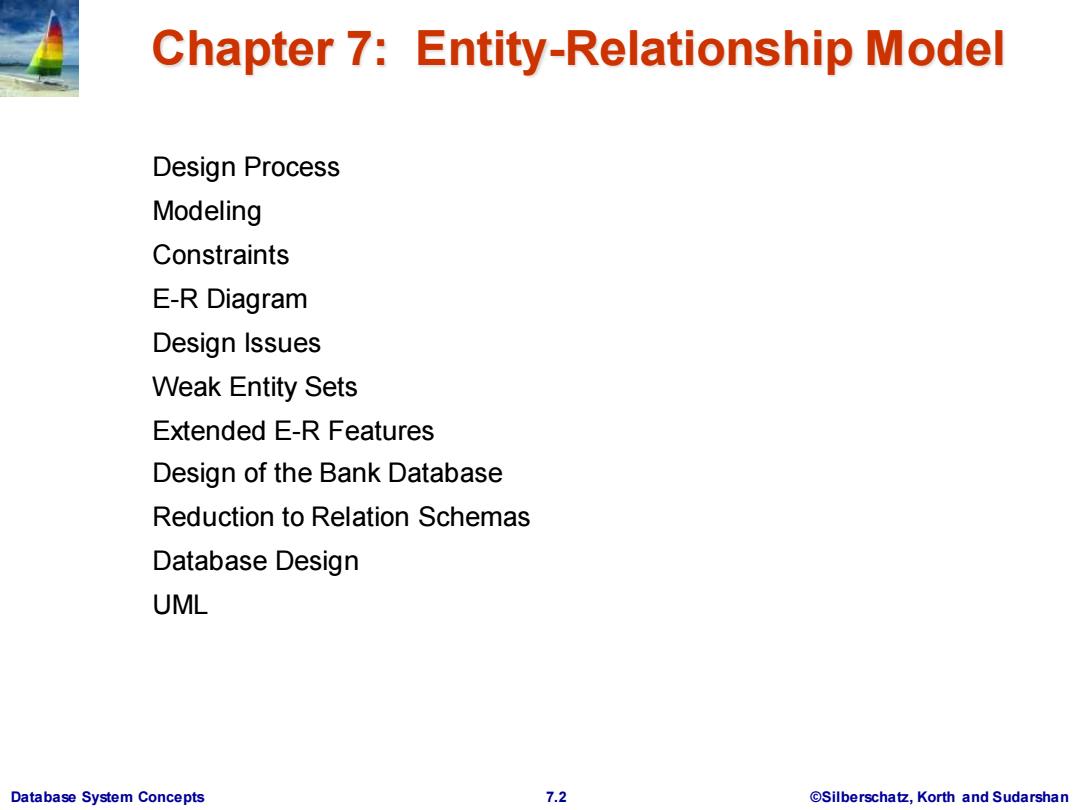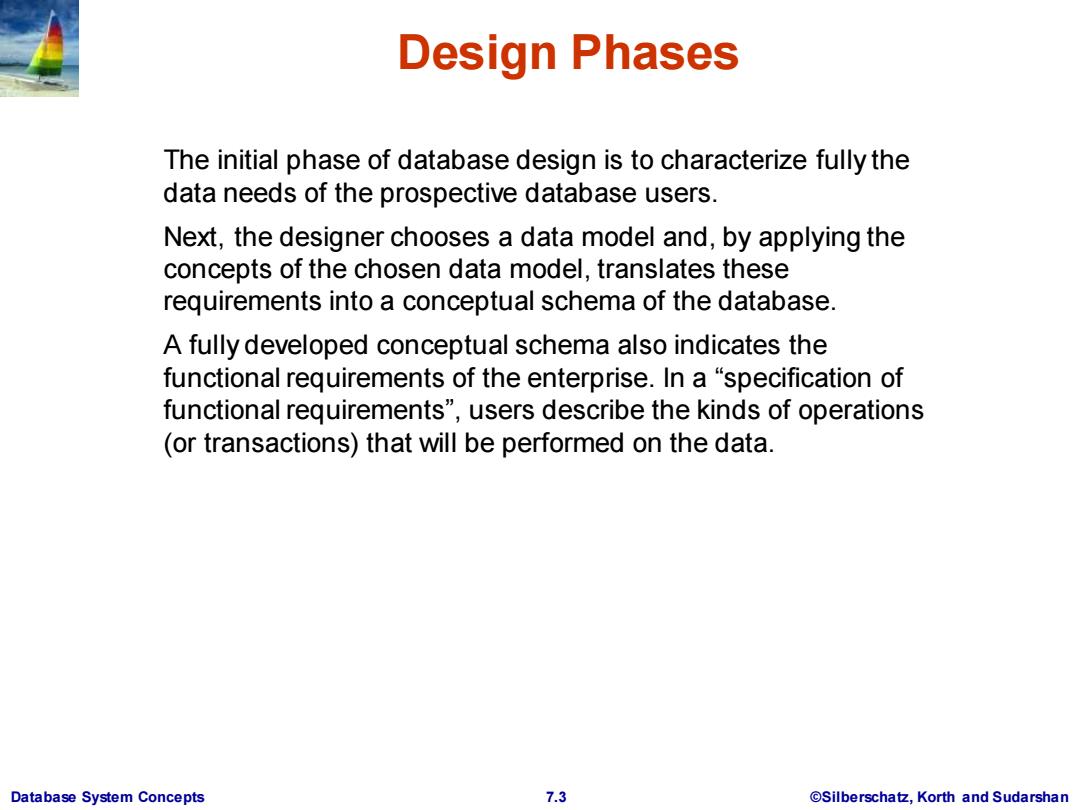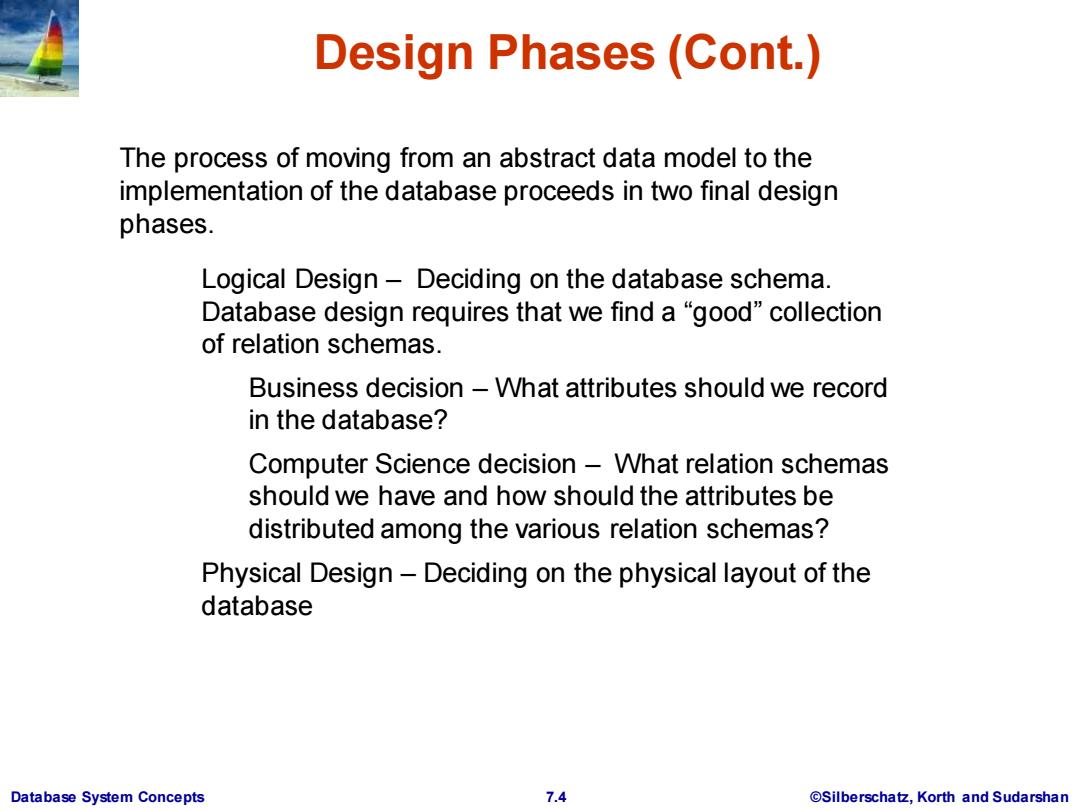
Chapter 7:Entity-Relationship Model Design Process Modeling Constraints E-R Diagram Design Issues Weak Entity Sets Extended E-R Features Design of the Bank Database Reduction to Relation Schemas Database Design UML Database System Concepts 7.2 @Silberschatz,Korth and Sudarshan
Database System Concepts 7.2 ©Silberschatz, Korth and Sudarshan Chapter 7: Entity-Relationship Model Design Process Modeling Constraints E-R Diagram Design Issues Weak Entity Sets Extended E-R Features Design of the Bank Database Reduction to Relation Schemas Database Design UML

Design Phases The initial phase of database design is to characterize fully the data needs of the prospective database users. Next,the designer chooses a data model and,by applying the concepts of the chosen data model,translates these requirements into a conceptual schema of the database. A fully developed conceptual schema also indicates the functional requirements of the enterprise.In a "specification of functional requirements",users describe the kinds of operations (or transactions)that will be performed on the data. Database System Concepts 7.3 @Silberschatz,Korth and Sudarshan
Database System Concepts 7.3 ©Silberschatz, Korth and Sudarshan Design Phases The initial phase of database design is to characterize fully the data needs of the prospective database users. Next, the designer chooses a data model and, by applying the concepts of the chosen data model, translates these requirements into a conceptual schema of the database. A fully developed conceptual schema also indicates the functional requirements of the enterprise. In a “specification of functional requirements”, users describe the kinds of operations (or transactions) that will be performed on the data

Design Phases(Cont.) The process of moving from an abstract data model to the implementation of the database proceeds in two final design phases. Logical Design-Deciding on the database schema. Database design requires that we find a "good"collection of relation schemas. Business decision -What attributes should we record in the database? Computer Science decision-What relation schemas should we have and how should the attributes be distributed among the various relation schemas? Physical Design-Deciding on the physical layout of the database Database System Concepts 7.4 ©Silberschat乜,Korth and Sudarshan
Database System Concepts 7.4 ©Silberschatz, Korth and Sudarshan Design Phases (Cont.) Logical Design – Deciding on the database schema. Database design requires that we find a “good” collection of relation schemas. Business decision – What attributes should we record in the database? Computer Science decision – What relation schemas should we have and how should the attributes be distributed among the various relation schemas? Physical Design – Deciding on the physical layout of the database The process of moving from an abstract data model to the implementation of the database proceeds in two final design phases

Design Approaches Entity Relationship Model(covered in this chapter) Models an enterprise as a collection of entities and relationships Entity:a“thing”or“object'”in the enterprise that is distinguishable from other objects -Described by a set of attributes Relationship:an association among several entities Represented diagrammatically by an entity-relationship diagram: Normalization Theory(Chapter 8) Formalize what designs are bad,and test for them Database System Concepts 7.5 @Silberschatz,Korth and Sudarshan
Database System Concepts 7.5 ©Silberschatz, Korth and Sudarshan Design Approaches Entity Relationship Model (covered in this chapter) Models an enterprise as a collection of entities and relationships Entity: a “thing” or “object” in the enterprise that is distinguishable from other objects – Described by a set of attributes Relationship: an association among several entities Represented diagrammatically by an entity-relationship diagram: Normalization Theory (Chapter 8) Formalize what designs are bad, and test for them

Outline of the ER Model Database System Concepts 7.6 @Silberschatz,Korth and Sudarshan
Database System Concepts 7.6 ©Silberschatz, Korth and Sudarshan Outline of the ER Model